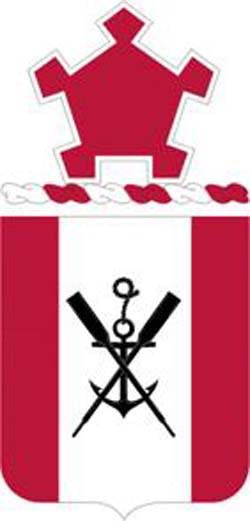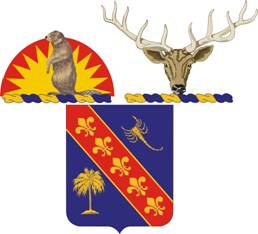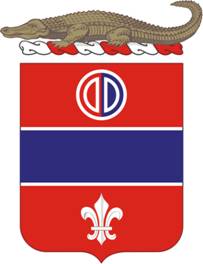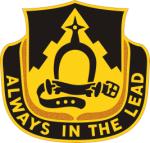
The 29th Infantry Division, also known as the "Blue and Gray Division", is an infantry division of the United States Army based at Fort Belvoir in Fairfax County, Virginia. The division is currently a formation of the Army National Guard and includes units from Kentucky, Maryland, North Carolina, South Carolina, Virginia, and West Virginia.

The 41st Infantry Division was an infantry division of the United States Army National Guard composed primarily of units from the Pacific Northwest. The division saw active service in World War I and World War II, receiving the nickname “Jungleers” during the latter.

The 34th Infantry Division is an infantry division of the United States Army, part of the National Guard, that participated in World War I, World War II and multiple current conflicts. It was the first American division deployed to Europe in World War II, where it fought with great distinction in the Italian Campaign.
Bruneau is an unincorporated community in Owyhee County in the southwestern part of the U.S. state of Idaho. The mouth of the Bruneau River is to the northwest and Bruneau Sand Dunes State Park is to the east. As of 2014, Bruneau has a population of 552.

The 116th Air Refueling Squadron is a unit of the Washington Air National Guard 141st Air Refueling Wing located at Fairchild Air Force Base, Spokane, Washington. The 116th is equipped with the KC-135R Stratotanker and RC-26B Metroliner.

The 116th Infantry Regiment is an infantry regiment in the Virginia Army National Guard.
The Snake River Valley Railroad built a rail line on the left (southeast) bank of the Snake River between Wallula and Grange City, Washington, United States, a distance of 65.85 miles (105.98 km). The company was incorporated in Oregon on March 3, 1898, and opened its line, operated by the Oregon Railroad and Navigation Company (OR&N), on December 1, 1899. It connected to the OR&N at both ends, providing a better route to Spokane than the existing line via Walla Walla. The properties of both companies were conveyed to new Union Pacific Railroad (UP) subsidiary Oregon–Washington Railroad and Navigation Company on December 23, 1910.
The Oregon, Washington and Idaho Railroad built a 72.03-mile (115.92 km) rail line along the right (north) bank of the Snake River between Riparia, Washington and Lewiston, Idaho. The company was incorporated in Oregon on August 8, 1903, and began operating its completed line on July 7, 1908, as an operating subsidiary of the Union Pacific Railroad, which also controlled the Oregon Railroad and Navigation Company (OR&N) through Riparia. A portion of the preliminary work had been done by the Snake River Valley Railroad, which built a completed line along the Snake River below Riparia. Beginning on December 3, 1909, the Camas Prairie Railroad, a joint subsidiary of the OR&N and Northern Pacific Railway (NP), began operating the Oregon, Washington and Idaho Railroad as part of a line between Riparia and Grangeville, Idaho, including segments owned by the NP and subsidiary Clearwater Short Line Railway. On December 23, 1910, the property of the Oregon, Washington and Idaho was conveyed to new Union Pacific subsidiary Oregon–Washington Railroad and Navigation Company, successor to the OR&N, but the Camas Prairie Railroad continued to operate it as agent.

The 116th Cavalry Brigade Combat Team is the largest formation of the Idaho Army National Guard. It is headquartered at Gowen Field, Boise, Idaho. It has been reorganized into an Armored Brigade Combat Team (ABCT) but remains the only unit to be designated a "Cavalry Brigade Combat Team" by special appointment of the US Army. The 116th Cavalry Brigade Combat Team has units located throughout Idaho, Montana, Oregon, and Nevada. It was reorganized into a heavy armor brigade in 1989. Often referred to as the Snake River Brigade and formerly known as the 116th Armored Cavalry Regiment, the unit includes about 3,000 citizen-soldiers from Idaho.

The 163rd Infantry Regiment is a regiment of the Montana National Guard. It went overseas with the 41st Infantry Division in World War II.

The 2nd Engineer Battalion is an engineer battalion in the United States Army which can trace its lineage back to 1861.

The 146th Field Artillery Regiment is a field artillery regiment of the Army National Guard first Constituted in 1886 as the 1st, and 2nd Regiments of Infantry.

The 148th Field Artillery Regiment is a Field Artillery Branch regiment of the Army National Guard.

The following works deal with the cultural, political, economic, military, biographical and geologic history of pre-territorial Idaho, Idaho Territory and the State of Idaho.

The 116th Field Artillery is a regiment of the Florida Army National Guard. Currently there are two battalions; 2-116th FA is fires battalion for the 53rd Brigade Combat Team, and 3-116th (HIMARS) is part of the 164th Air Defense Artillery Brigade, both of the Florida Army National Guard.

Fort Colville was a U.S. Army post in the Washington Territory located three miles (5 km) north of current Colville, Washington. During its existence from 1859 to 1882, it was called "Harney's Depot" and "Colville Depot" during the first two years, and finally "Fort Colville". Brigadier General William S. Harney, commander of the Department of Oregon, opened up the district north of the Snake River to settlers in 1858 and ordered Brevet Major Pinkney Lugenbeel, 9th Infantry Regiment to establish a military post to restrain the Indians lately hostile to the U.S. Army's Northwest Division and to protect miners who flooded into the area after first reports of gold in the area appeared in Western Washington newspapers in July 1855.

Almota is an extinct town in Whitman County, in the U.S. state of Washington. The GNIS classifies it as a populated place.
Farrington is an unincorporated community in Franklin County, in the U.S. state of Washington.

Imhaha was a stern-wheel steamboat which operated on the Snake River in the Pacific Northwest in 1903. The steamer was built, launched, placed in service, and wrecked within a single year. The rapids on the Snake river had only rarely been surmounted by a steamboat, and generally only with the aid of a steel cable for lining used to winch the entire boat upstream through the rapids. After only a few trips, Imnaha was destroyed in Mountain Sheep rapids, just downstream from the mining settlement of Eureka, on the Oregon side of the river.

The 303rd Cavalry Regiment is a United States cavalry regiment, currently represented in the Washington Army National Guard by the 1st Squadron, 303rd Cavalry, headquartered at Vancouver, Washington, part of the 96th Troop Command. It incorporates the lineage of the 303rd Cavalry, 303rd Armor, and 803rd Armor Regiments of the Washington Army National Guard.


















